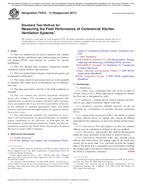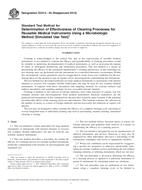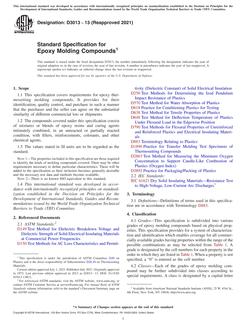1.1 This test method employs a direct interface gas chromatograph/mass spectrometer (GCMS) to identify and quantify the 36 volatile organic compounds (or sub-set of these compounds) listed as follows. The individual Chemical Abstract Service (CAS) numbers are listed after each compound.
| Benzene-71432 | Methylene chloride-75092 |
| Bromodichloromethane-75274 | 1,1,2,2-Tetrachloroethane-79349 |
| Carbon disulfide-75150 | 1,1,1-Trichloroethane-71556 |
| Chloroform-67663 | 1,1,2-Trichloroethane-79005 |
| Methyl iso-Butyl ketone-108101 | p-Xylene-106423 |
| Styrene-100425 | Bromomethane-74839 |
| Tetrachloroethylene-127184 | Carbon tetrachloride-56235 |
| Toluene-108883 | Chlorobenzene-108907 |
| Bromoform-75252 | c-1,3-Dichloropropene-10061015 |
| Vinyl acetate-108054 | 1,2-Dichloroethane-156592 |
| Vinyl chloride-75014 | 1,1-Dichloroethene-75354 |
| Chloromethane-74873 | t-1,2-Dichloroethene-156605 |
| cis-1,2-Dichloroethene-156592 | Methyl ethyl ketone-78933 |
| Dibromochloromethane-124481 | 2-Hexanone-591786 |
| 1,1-Dichloroethane-107062 | t-1,3-Dichloropropene-542756 |
| 1,2-Dichloropropane-78875 | Trichloroethene-79016 |
| Ethylbenzene-100414 | m-Xylene-108383 |
| Ethyl chloride-75003 | o-Xylene-95476 |
1.2 The test method incorporates a performance-based approach, which validates each GCMS analysis by placing boundaries on the instrument response to gaseous internal standards and their specific mass spectral relative abundance. Using this approach, the test method may be extended to analyze other compounds.
1.3 The test method provides on-site analysis of extracted, unconditioned, and unsaturated (at the instrument) gas samples from stationary sources. Gas streams with high moisture content may require conditioning to prevent moisture condensation within the instrument. For these samples, quality assurance (QA) requirements are provided in the test method to validate the analysis of polar, water-soluble compounds.
1.4 The instrument range should be sufficient to measure the listed volatile organic compounds from 150 ppb(v) to 100 ppm(v), using a full scan operation (between 45 and 300 atomic mass units). The range may be extended to higher or lower concentrations using either of the following procedures:
1.4.1 The initial three-point calibration concentrations and the continuing calibration checks are adjusted to match the stack concentrations, or
1.4.2 The three-point calibration is extended to include additional concentrations to cover the measurement range.
1.5 The minimum quantification level is 50 % of the lowest calibration concentration. Responses below this level are considered to be estimated concentrations, unless a calibration standard check is conducted at a lower concentration to demonstrate linearity. The sensitivity of the GCMS measurement system for the individual target analytes depends upon:
1.5.1 The specific instrument response for each target analyte and the number of mass spectral quantification ions available.
1.5.2 The amount of instrument noise, and
1.5.3 The percent moisture content of the sample gas.
This standard does not purport to address all of the safety concerns, if any, associated with its use. It is the responsibility of the user of this standard to establish appropriate safety and health practices and determine the applicability of regulatory limitations prior to use.
Product Details
- Published:
- 10/01/2004
- Number of Pages:
- 7
- File Size:
- 1 file , 110 KB


